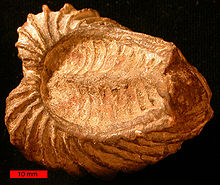Trigoniidae
| Trigoniidae | ||||||||||||
|---|---|---|---|---|---|---|---|---|---|---|---|---|

Neotrigonia margaritacea , Victoria, Australia |
||||||||||||
| Systematics | ||||||||||||
|
||||||||||||
| Scientific name | ||||||||||||
| Trigoniidae | ||||||||||||
| Lamarck , 1819 |
The Trigoniidae , less commonly also triangular clams , are a family of the order Trigoniida within the palaeoheterodont clams . The first representatives of the family appear already in the Middle Triassic . Today there is still one genus ( Neotrigonia ) with about seven species.
features
The housings of the Trigoniidae are usually heavily ornamented. This ornament consists of ribs or knots arranged in rows. The flaps are uniform and relatively thick. The front edge is rounded, the rear edge can be slightly elongated. The vertebra protrudes far forward. The ligament is external. The left flap has a deeply sunk triangular tooth and anterior and posterior cardinal numbers. On the right valve there are two V-shaped cardinal teeth that show transverse notches. The sphincter impressions are clear and the edge of the mantle is integripalliat over the entire margin . The foot is relatively large and muscular. The shell can "jump" with it; most of the time, however, the foot is used for digging or moving in the sediment.
Way of life
Today's Trigonia live buried in sandy deposits in water depths of up to 400 m. Most fossil trigonia were found in sedimentary rocks that were originally deposited in the sea a few tens of water depths.
evolution
The family Trigoniidae presumably descends from the Triassic Myophoriidae and experienced a rapid diversification in the Jura , which reached a high point in the Lower Cretaceous . In the Upper Cretaceous the number of genera fell sharply and there was an almost extinction on the Cretaceous-Tertiary border . Only a few forms are known from the Paleogene ("Tertiary"). Today the family is only represented by one genus ( Neotrigonia ) that lives in the coastal waters off South Australia.
Systematics
The family Trigoniidae is divided into subfamilies very differently by the individual scientists. Currently, up to 20 subfamilies (with up to 100 genera) are differentiated. Due to the great systematic uncertainty, other authors dispense with a classification into subfamilies and instead only list the genera. Some of the previous subfamilies are in turn viewed by some authors as independent families (e.g. (sub) family Neotrigoniidae).
Some fossil genera:
- Trigonia (Middle Triassic to Upper Cretaceous)
- Agonisca (Middle Triassic)
- Geratrigonia (Lower Jurassic)
- Iotrigonia (chalk)
- Maoritrigonia (Upper Triassic)
- Sphenotrigonia (Upper Cretaceous)
- Yaadia (chalk)
literature
- LR Cox et al .: Order Trigonioida . In: Moore, RC (Ed.) Treatise on Invertebrate Paleontology, Part N, Mollusca 6, Bivalvia: 471-489, 1969.
- TA Darragh: The Cainozoic Trigoniidae of Australia . Alcheringa 10: 1-34, 1986.
Web links
- Sven Weidemeyer: Trigonia - “The cockles of the Mesozoic Era” ( Memento from September 27, 2007 in the Internet Archive ) at www.steinkern.de

